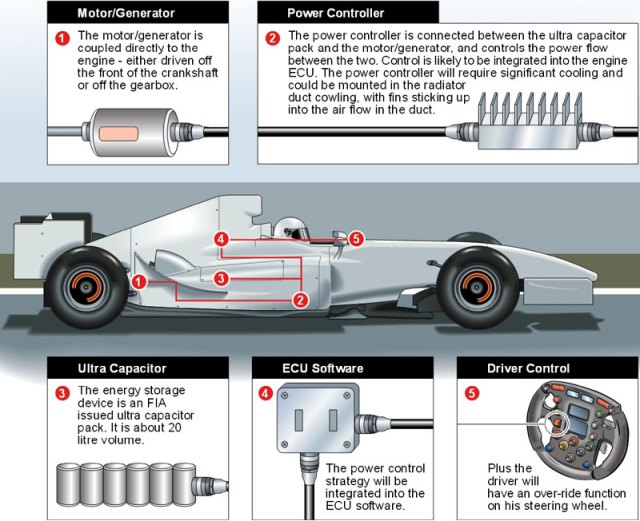Formula 1 will be too exciting, fast-paced, and full of adrenaline-packed actions in its 2011 season with the announcement of new F1 sporting and technical regulations. Let us take a look at the new regulations set by Formula One Administration Ltd. and Federation Internationale de l’Automobile (FIA) for next F1 season.
107% Qualifying Rule
The 107% Qualifying Rule is reintroduced during the first phase of the qualification round. Under this rule, an F1 driver must be able to set his time within 107% of the fastest Q1 time set. In the event that his time falls below the prescribed time, the race stewards will not be permitted to start the race. However, under exceptional circumstances, a driver who sets an appropriate time during practice will be allowed by the steward to start. For example, if the fastest lap set in the circuit is 1 minute and 30 seconds, other drivers must be able to set time not beyond 1 minute and 36 seconds to make it to the grid.
Tires
Italian tire manufacturer Pirelli is the new sole tire supplier in the 2011 F1 season. Bridgestone did not renew its contract at the end of the 2010 season after 13 years of supplying tires for F1 teams. Pirelli was awarded the rights to supply tires for 2011 after thorough deliberations at the FIA World Motor Sport Council meeting in Geneva last June 2010.
Tire allocation is also reduced to only 11 sets of dry tires rather than 14 sets for each driver during race weekend. Drivers will receive allocation of three sets (two primary, one option) to be used during P1 and P2 sessions. Teams must return one set after each session of their drivers. As an additional rule condition, a driver that fails to use both specified dry-weather tires during a race will be excluded from the results. If a (dry) race is suspended and can’t be restarted, and a driver has failed to use both specifications, the driver’s race time will be penalized with 30 seconds.
Cancellation of F-ducts or double diffusers
Alteration of the aerodynamic characteristics of the F1 car that requires driver movement is banned in the 2011 season. F-ducts which require driver control are found unsafe. Double diffusers are also prohibited to be included in the car designs.
Additional Wheel Tethers
- F1 double wheel tethers for added safety
FIA has ordered to double the number of wheel tethers to improve safety measures on each F1 cars. There are several stray wheel accidents during the 2010 season. The new double wheel tethers must be contained in separate suspension members.
KERS
KERS or Kinetic Energy Recovery Systems are reintroduced in 2011 after F1 teams mutually agreed to suspend their use in the 2010 season. However, the use of KERS in 2011 is an optional requirement for teams. KERS makes use of waste energy generated under braking and converts it into additional power.
Adjustable Rear Wings
Adjustable rear wings are now allowed under new moveable bodywork regulations set by FIA. Drivers can now adjust the rear wing of their cars from the cockpit to alter its angle of incidence through a set range. The new system is electronically controlled and can be used any time during practice and qualifying sessions. But during race day, the rear wings can only be activated when a driver is less than one second behind another car at pre-determined points on the circuit. The system is then deactivated once the driver performs braking actions. The use of KERS improves overtaking maneuvers. The adjustable rear wings is also optional the same as KERS.
Race Penalties
Race stewards are now given more power to impose extensive range of penalties for illegal driving, overly-aggressive driving, and other rule transgressions. Also included are time penalties, the power to exclude drivers from race results, or suspend them from subsequent events. In the last Hungarian Grand Prix, Michael Schumacher forced Rubens Barrichello on the pit wall that could have resulted to a catastrophic accident. Schumacher escaped a stiffer penalty on his illegal driving.
Team curfew
F1 team personnel connected with the operation and maintenance of cars are now under curfew to avoid long working hours in the team’s pit. They will not be allowed to enter the circuit between midnight and 6am when practice is scheduled to start at 10am the following day, or between 1am and 7am when practice starts at 11am. However, each F1 team is allowed four individual exceptions to this rule during the season.
Team orders
Team orders will now be in effect. However, coded messages are not allowed and will be meted out with penalties if found out to deceive stewards and spectators. Ferrari was hit by team order controversy during the 2010 season.
Gearboxes
F1 teams are now allowed to use their gearboxes to last for five race weekends instead of the previous practice of four. This is in lieu of Formula 1’s cost-saving and environmental initiatives.
Technical Regulations: Formula1.com and Federation Internationale de l’Automobile (FIA) Image credit: Sutton Motorsports








